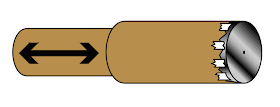In order to understand some of the basics about lenses and optics, "pinholes" make a good start. Plus, it's easy enough to build a pinhole viewer (or "camera") from everyday items. The idea is to get the image projected from the pinhole to light up a "screen" and make the surroundings dark enough to see the resulting projected image.
The "cardboard tube pinhole camera" has many varieties. But I decided to try my hand at upscaling the project. Just like sedimentary particles, it's always fun to go big, so I made a bigger one that zooms in and out, changing the apparent magnification of the image:
 Here's the completed Pinhole Zoom Viewer.
Here's the completed Pinhole Zoom Viewer.
I was fortunate to have two thick cardboard poster tubes that nested inside each other, This made it easier to assemble. You could make nesting tubes by rolling tagboard or heavy paper, but there would be some additional work to smooth out the seams so that extra light won't leak in.

To start, gather the necessary materials: two nesting cardboard tubes (light-proof), a sheet of aluminum foil large enough to cover one end of the large tube, a sheet of wax paper (tracing paper might work too) to cover one end of the small tube, and some tape. You may also need scissors, extra black construction paper and stuff to "pimp out" your viewer.

Cover one end of the large tube with aluminum foil. Keep the foil taught (like a drum head) over the tube's opening. Tape it down so that no light can get in around the sides. Cover one end of the small tube with the wax paper - this is your projection screen. The "screen" end goes into the bigger tube. Make sure there's enough space to slide it in, but not so much that light can get in around the edges (sense a theme here?). Now take a narrow pin, or paper clip, and punch a narrow pinhole in the center of the foil. This pinhole should be somewhere between 0.5 and 1 mm in diameter (check the web for further discussion on the pinhole diameter - and discussion about making the foil more effective).
The reason for the long tube between your eye and the image "screen" is so that it's dark. You can fashion a "hood" around the viewport to block even more light with additional construction paper, as I did with my version. Although if you snug the tube up to your eye, you can probably get it to work okay.

Since the projected image is of a certain size, by extending the tube, you effectively "zoom" in on a small portion of that image, increasing the apparent magnification (this is part of the reason why "zoom" lenses on cameras do what they do). To take in a wider view, push the tube in. This typically works best outdoors in bright sunlight - although you can see the effect by looking at a light source (like a light bulb or candle) indoors.

Here's a quick test I did by placing my zoom viewer on top of a digital camera and lens (exposure time of a couple of seconds at ISO 800). You could try to place the pinhole viewer directly on the camera body (without lens), but if you're not familiar with how to keep the image sensor clean, you might want to hold off on that step. My next test images will probably be to set up the viewer on a tripod and take a picture of some objects outdoors (but the rain today and tomorrow will probably delay those plans).
Anyway, this project seems to work well for "kids" of any age. Even cynical college students get a kick out of seeing an image through these things. And it only takes a few minutes to build the simple ones.
UPDATE (10/12/2010): I have another post about turning your DSLR into a pinhole camera.











